King's Troop 1822-2011
Royal Horse Artillery
St Johns Wood 1804
In 1804, a barracks had been built in Brick Field, at the southern tip of the Eyre Estate. Soon after it moved to a new site near the old St John’s Wood Farm, as a home for the Royal Artillery. In 1823 the Army needed to remove the Riding Establishment from Pimlico and the Commander in Chief decided the proper place would be ‘the Barrack at St John’s Wood belonging to the Ordnance’.
The Riding School, which was designed by the Royal Engineers, and built there in 1825 (costing £5712 4s 9d) was of an unusual width. From 1825, it was a cavalry riding establishment, from 1832 – 1876 the Foot Guards were there, then the Household Cavalry for four years and finally, in 1880, the Royal Horse Artillery. In 1854 it had been noted that there were 228 men there, with but a single bath.
The naming of the Troop –
After the Second World War, the artillery was mechanised but King George VI wanted to keep a troop of horse artillery mounted and dressed in the traditional manner. When he signed the Visitor’s Book at the Barracks in 1947 he crossed out ‘Riding’ and inserted ‘King’s’ Troop as the name of the ceremonial saluting battery.
In 1952, when Queen Elizabeth ascended the throne she decided the name should remain the King’s Troop in honour of her father. The Troop takes precedence over all other regiments and parades and is always on the right of the line of the British Army.
The soldiers and their work –
Not all the soldiers are expert equestrians before they join the Troop and, indeed, some have never even ridden a horse. They are trained to drive a team of 6 horses that pull the ‘thirteen pounder’ State saluting gun. Salutes are fired for Royal anniversaries, and State occasions, as well as Remembrance Day, and the Lord Mayor’s Show. Black horses and a gun carriage are supplied for State funerals. The Troop, also, perform a musical drive at events such as the Royal Tattoo at Windsor Castle.
111 horses are stabled at the barracks and local residents enjoy hearing them ride by for exercise every day, with the soldiers in ordinary uniform, as well as the special occasions when they ride out with all the dress uniforms and equipment gleaming. In the last twenty years or so, female soldiers have joined the Troop.
The King’s Troop also has to be prepared for tasks in support of the Territorial Defence of the UK. Such tasks could include Military Aid to the civil community and they recently took part in Operation Fresco when the firemen went on strike.
Training –
Soldiers joining the Troop spend the first three to four years working as a Mounted Gunner before they can get the chance to be employed as saddlers, farriers, tailors, storemen, vehicle drivers or orderlies. They also have to be taught to ride the military way where you are not allowed to move from one position – the horse is held with one hand and the sword with the other.
A typical day starts at 6 a.m. mucking out the horses, at 7 a.m. the horses are taken out for exercise, one soldier riding a horse and taking another two by hand around the London streets for an hour and a half. At 8.30 a. the horses are fed, then the soldiers are given their breakfast. At 9.15 a.m. the horses are given hay, swept out and groomed. After lunch at 12.30 p.m. uniforms [a blue tunic trouser suit, Busby hat, and long riding boots] are cleaned, at 4.30 p.m. the horses are fed, and again at 6.30 p.m.
Farewell to the Troop –
The Troop are moving to Woolwich in 2012, when the lease with the Eyre estate runs out. The 1000 tonnes of manure produced by the horses each year will be used to create pellets to provide hot water and heating in the new barracks. On 30 June 2011 the Queen paid a final visit to the barracks. The Riding School is a listed building and will remain when the rest of the site is developed for housing. St John’s Wood residents will miss presenting the Troop with goody bags on Christmas Eve, when the horses wear an assortment of reindeer horns, but most of all miss them riding by each day.

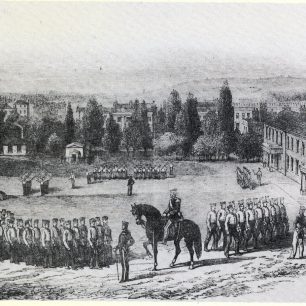
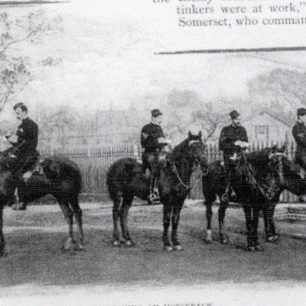
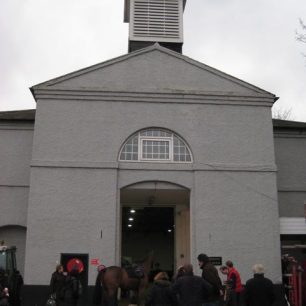
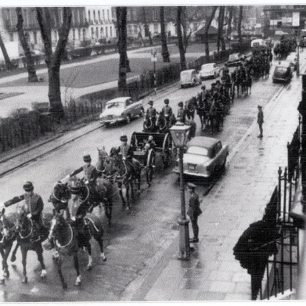
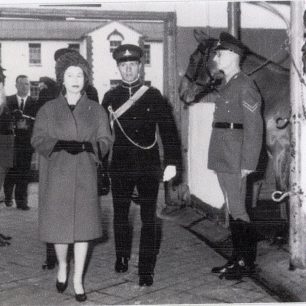
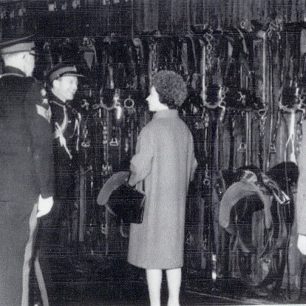
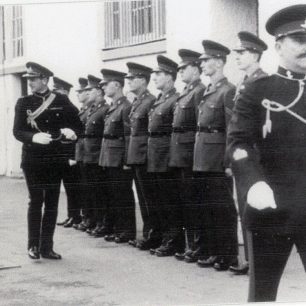
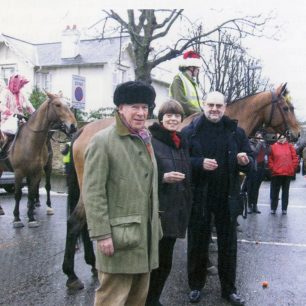
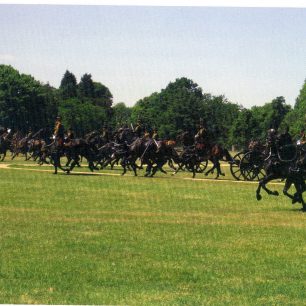
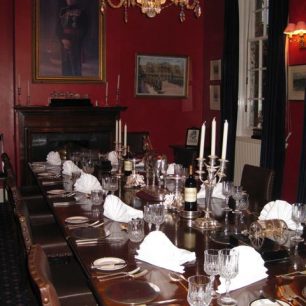
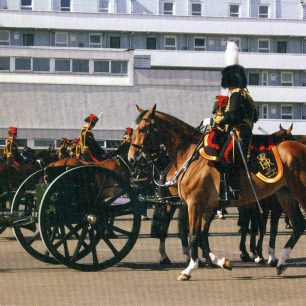
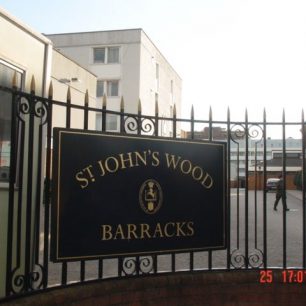



Comments about this page
My stepfather Edward James Wells joined the Kings Troop RHA at Wellington Barracks just as World War 2 broke out in 1939. He was wounded and taken prisoner at Tobruck. He spent the war in various Prison Camps in Europe including Stalag 8 and others and he was also on the Long March. He was a great man.
I grew up on West End Lane , West Hampstead. One of my very fond early memories from the 1960s was watching the whole troop go by early in the morning. It was quite a spectacle and I can still hear the stirrups, the horses and general clatter along the street. So special.
I was attached to the Kings Troop as a R.E.M.E vehicle mechanic looking after the transport and staff cars at around 1972. I worked under the “Tiffy” sergeant Dave Wright. This was a very unusual posting and I was proud of my involvement with the Troop. On leaving the Troop I was posted to another R.E.M.E. Workshop and was presented with an original pencil drawing of the Troop entering the new barracks in St Johns Wood which I was very proud of. Unfortunately the picture was destroyed in a house fire in later years. At the age of 72 I often reminisce of those happy times.
I use to be a 13 yr old paper-round girl and part of my paper-round was Goldhurst Terrace in West Hampstead. I used to see the King’s Troop exercising the horses around the street and was always thrilled to see, smell (yes, smell.. lovely horse smell) and hear the horses. Buckets and shovels would appear when they had rode past and there would be a few very happy gardeners. Later, I met and became engaged to a member of The King’s Troop. Sad to think The King’s Troop will no longer be a presence on the streets of St John’s Wood. This was some 40 years ago. I have only just discovered your website. I now live in Devon and have not been back to St John’s Wood since I moved from Abbey Road 40 years ago…… bet there are quite a few changes!
Add a comment about this page